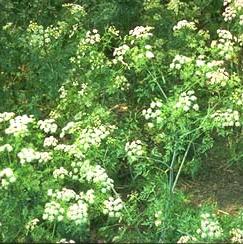Piperidine Alkaloids
Piperidine alkaloids are identified by their saturated heterocyclic ring, i.e., piperidine nucleus. The best known piperidine alkaloid poisons are those of poison hemlock, Conium maculatum. Socrates is reputed to have been killed with a poison hemlock extract. There are at least 5 naturally occurring conium alkaloids. .
Conium maculatum (Poison Hemlock)

Poison hemlock is native to Europe. However, it is now widely distributed across the United States, especially in the Northern states. It is common along roadsides, hiking trails, ditches and field borders.
Poison Hemlock can grow to be about 6 to 10 ft. tall. It has leaves and white flowerheads resembling those of parsnips, carrots, and water hemlock. It has a fleshy, white taproot, a main stem with characteristic light red spots and a disagreeable smell. All plant parts are poisonous. However, the seeds contain the highest concentration of poison. The conium alkaloids are volatile and can even cause toxic reactions when inhaled.

Note the characteristic red mottling on the stems.
How to distinguish from other plants
Water hemlock does not have the same main taproot and stem. Instead, water hemlock has a branching, tuberous root stalk similar to that of a dahlia plant. The lower part of the stem of water hemlock is divided into chambers which contain its toxicant. Poison Hemlock is also commonly confused with wild carrot, cow parsnip, etc. Human deaths have occurred from harvesting and consuming the roots as wild carrots or parsnips. The stems should always be checked for red mottling. However, this characteristic is not always readily apparent.
More information describing this plant can be found under Poison Hemlock in the Canadian Poisonous Plants Information System, courtesy of DerekB. Munro.
Symptoms of Poisoning
Conium alkaloids acutely affect the nervous system. Livestock progress from:
- nervousness
- trembling
- incoordination
- dilated pupils
- weak heartbeat
- cold extremities
- coma
- to death by respiratory failure.
-Conium Alkaloids are teratogenic agents.
Livestock most affected
- Swine (1g of C. maculatum seed/kg lw given orally) - Lethal
- Cattle (3.3 mg coniine/kg lw given orally) - Severe toxic signs
- Horses (15.5 mg coniine/kg lw given orally) - Severe toxic signs
- Sheep (44 mg coniine/kg lw given orally) - Moderate toxic signs
Fresh plant is enthusiastically consumed by pigs in feed trials. Third eyelid expands over entire eye about 15 minutes after poisoning causing temporary blindness. Weakness, trembling, and lethargy are observed. Both seeds and foliage are teratogenic in swine causing cleft palates in piglets exposed at 30 to 45 days gestation, and arthroryposis, scoliosis, hydrocephalus, and severe contraction of fetlock joints in piglets exposed at 43 to 61 days gestation.
Cattle are about ten times more vulnerable than sheep apparantly because of differences in liver metabolism. An injectable dose of 16 mg coiinine/kg live weight is lethal in cows. Field trials have induced crooked calf disease in the offspring of cows fed poison hemlock or dosed with conium alkaloids, implicating poison hemlock as a likely cause of deformed calves on ranges with no lupine herbage present.
Although horses are readily poisoned by poison hemlock, field trials thus far have not been able to induce teratogenic responses in pregnant mares poisoned with conium alkaloids, indicating that the horse fetus may be resistant to these toxins.
Signs of poisoning in sheep are restlessness, followed by tremors and ataxia. The lethal dose for sheep is @ 240 mg coiinine/kg live weight. Their resistance to poisoning when compared to cattle is attributed to species differences in liver metabolism. Research indicates that poison hemlock is not teratogenic in sheep.
Prevention of livestock poisoning
Swine paddocks should be monitored for poison hemlock because swine will readily eat it. Poison hemlock is not highly palatable to cattle, horses, and sheep and rarely will they eat a toxic amount of it if more palatable vegetation is available on the range. Because conium alkaloids are teratogenic to cattle, care should be taken that cows in the first 3 mo of pregnancy not be grazed on sparse pastures with an appreciable population of poison hemlock. The seeds contain the highest concentration of toxicants. Therefore, feed grain can potentially be contaminated with poison hemlock. Although, herbicides and routine cultivation severely reduce the amount of poison hemlock in grain fields, seed contamination is still a potential danger in unsprayed or newly established grain fields.
[Poison Hemlock] [Symptoms of poisoning] [Livestock most affected] [Prevention of poisoning] [return to list of toxicants]